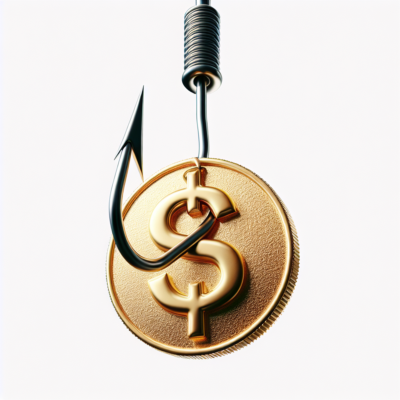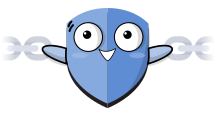What Should You Do if You Suspect an Email is a Phishing Attempt?
Spotting a phishing email is only half the battle; knowing what to do next is equally crucial to safeguarding your organization. If you suspect an email is a phishing attempt, here are the recommended steps to follow:
- Don't Interact: First and foremost, avoid clicking on any links or downloading attachments within the email. Interacting with the content could be the opening attackers need to compromise your systems.
- Report It Immediately: Most organizations have protocols in place for reporting phishing emails. Inform your IT/security department as soon as possible. If your reporting channel is not clear then inform your manager. Perhaps your email client has a button to report the email.
Why is reporting important?
Reporting helps in:
- Swiftly mitigating any potential threat.
- Supporting the larger effort of tracking and neutralizing phishing campaigns targeting the organization.
Remember, phishing isn't just a minor nuisance; it's a gateway to more severe cyber threats that can jeopardize an organization’s data, reputation, and financial standing. Therefore, staying alert and proactive is not just a good practice—it's a critical necessity.
Picture this: it’s a typical Tuesday morning, and you’re navigating the deluge of emails flooding your inbox. Suddenly, a message pops up from your CEO, marked ‘urgent.’ It’s asking you to review an attached file or click a link. Your heart skips a beat. Should you act quickly because it’s from the boss, or could this be a cyber trap set by a malicious actor?
In the world of cybersecurity, phishing emails are the wolves dressed in sheep's clothing, and they prey on our instincts to trust and respond swiftly. Surprisingly, over 90% of cyber-attacks begin with a single phishing email. This staggering statistic underscores the significance of identifying these digital time bombs before they explode.
As leaders in our field, we bear the responsibility not only to defend but to educate and fortify our teams against such threats. Our mission is to arm you with the essential tips and tricks necessary to spot phishing emails with the precision of a seasoned detective. Let’s dive in and explore the art of discerning the genuine from the devious.
 Why is it called phishing?
Why is it called phishing?
Imagine you're fishing – same premise but in the digital ocean. Instead of a baited hook, cybercriminals use email as their lure, hoping to reel in unsuspecting victims.
Phishing is a form of cyberattack where attackers impersonate legitimate entities to deceive individuals into divulging sensitive information, such as usernames, passwords, or financial details. The ultimate goal? To gain unauthorized access to valuable data or assets – quite a catch for them, and potentially disastrous for you.
Think of a phishing email like a chameleon, blending in just enough to fool its prey. Phishing is a social engineering attack where attackers send deceptive emails impersonating reputable entities to steal sensitive information, such as login credentials or financial data. The variations of phishing scams are as diverse as they are cunning—ranging from the broad strokes of generic phishing to the highly targeted strikes of spear phishing and whaling.
Anatomy of a Phishing Email
Just like identifying counterfeit currency, recognizing phishing emails starts with understanding their anatomy. Imagine a phishing email as a puzzle with numerous pieces fitting together to create a deceptive image. By dissecting these elements, we can learn to spot the subtle clues that betray their true nature.
1. The Hook
Think of the subject line and content as the bait. It’s designed to create a sense of urgency or curiosity. For example, “Immediate Action Required: Account Suspension Notice” is crafted to spark panic and urgency.
2. The Lure
Phishing emails often contain links or attachments that promise something enticing or demand immediate attention. Hovering over these links can often reveal a suspicious URL masked behind seemingly innocent text.
3. The Trap
Once you take the bait, the trap is set. Clicking the link might direct you to a fake website designed to harvest your credentials or install malicious software on your device.
Common Methods and Goals
The versatility of phishing attacks comes from their ability to evolve and adapt. Whether it's through email, social media, or phone calls, attackers are constantly refining their tactics.
- Spear Phishing: This targeted approach involves tailoring emails to a specific individual or organization, often using information from social media or other public sources to appear credible.
- Whaling: A specialized spear phishing targeting high-profile executives (hence the term "whale"). These attacks are meticulously crafted, often referencing real projects or executives to lower suspicion.
- Clone Phishing: In this method, attackers create a nearly identical copy of a legitimate email that the victim has previously received, replacing legitimate links with malicious ones.
As cybersecurity professionals, it's imperative to keep abreast of these evolving tactics. Sharing real-world examples and case studies within your organization can illustrate how easily one can be deceived and the potential repercussions of even a single slip-up.
What to look out for
By understanding the core elements and objectives of phishing, we lay the foundation for identifying and countering these threats effectively. Now, let’s delve deeper into the specific red flags to watch out for in phishing emails.
Suspicious Sender Addresses
The first clue often lies in the sender's address. At first glance, it may look legitimate, but upon closer inspection, subtle inconsistencies emerge. Cybercriminals frequently use email addresses that closely mimic those of trusted organizations, changing just a letter or two in the domain name. For example, [email protected] instead of [email protected].
Urgent Language
Phishing emails often employ urgent or fear-inducing language to prompt hasty decisions. They'll claim your account is compromised, your password needs resetting, or your immediate action is required to avoid severe consequences. This psychological manipulation is designed to override your usual cautiousness.
F ear of missing out (FOMO)
ear of missing out (FOMO)
Cybercriminals often exploit FOMO by highlighting limited-time offers or exclusive deals, creating urgency to act quickly. This pressure prevents rational thinking. Always validate such offers by visiting the official website or contacting the company through verified channels to avoid falling victim to these tactics.
Think of these emails as the digital equivalent of a car salesman who insists, "This deal is only good for the next 10 minutes!" – pushing you to act fast before you have time to think.
Poor Grammar and Spelling
Professional organizations usually ensure their communications are polished and error-free. Spotting grammatical errors or strange phrasings in an email claiming to be from a reputable source should raise immediate red flags. It's like receiving a business proposal written in text-message shorthand – not very convincing
Additionally, there is a theory that cyber criminals deliberately include these errors to filter out less gullible targets! The theory is that a target who overlooks these mistakes are seen as less likely to detect the scam later on, making them more susceptible to falling for the scam's final stages.
Suspicious Links and Attachments
Hover over any links before you click. Does the URL match the purported sender’s domain? Phishing URLs often have slight misspellings or unexpected extra characters. And be wary of unsolicited attachments, they might carry malware designed to infiltrate your systems.
A few years back, I received an email that appeared to be from a well-known subscription service. The sender’s address looked convincing, but something seemed off. I hovered over the link (or anchor) to reveal the destination (or href) and voila – the href and anchor did not match!
Unusual Requests
Finally, be cautious if an email requests sensitive information like login credentials or financial details. Legitimate organizations rarely, if ever, ask for such information via email. Always verify through trusted communication channels.
By honing in on these key traits, we can reduce the risk of falling victim to phishing attacks, safeguarding not just our own information, but the integrity of our entire organization.
In the next segments, we’ll dive deeper into advanced phishing techniques and share best practices for reporting and mitigating these attacks. Stay vigilant, stay informed, and remember: Awareness is your first line of defense.
Advanced Phishing Techniques
Now that we've laid the groundwork by identifying the common traits of phishing emails, let's step into deeper waters where the lures are more sophisticated and the stakes even higher. Advanced phishing techniques are like the digital equivalent of a master angler using finely tuned baits to catch the biggest fish. Here’s what you need to know to stay one step ahead of cyber attackers employing these advanced tactics.

Spear Phishing: The Personalized Attack
Think of spear phishing as the difference between a net thrown aimlessly into the ocean and a spear targeted at a specific fish. In spear phishing, attackers meticulously research their targets to create highly personalized emails. These emails could be crafted to appear as if they come from a trusted source within the recipient's network, such as a colleague, friend, or business partner. The familiar context increases the likelihood of the victim taking the bait.
For instance, imagine receiving an email from your CEO, addressing you by name and referencing a recent project. The email asks for critical login details to resolve an urgent issue. The email is persuasive, but it’s a spear-phishing attempt designed to exploit trust and familiarity.
Whaling: Targeting the Big Fish
While spear phishing targets employees at various levels, whaling focuses on senior executives and high-profile targets within an organization. These emails are designed with even greater precision, often incorporating industry-specific jargon or hierarchical nuances that only someone within the company would know.
A classic scenario involves receiving a meticulously crafted email from what appears to be the CFO, asking for a substantial financial transfer to a new vendor. The email includes formal language, authentic-looking digital signatures, and references to real company initiatives, making it incredibly convincing.
In 2016, Facebook paid over $100 million to fraudsters after an attacker impersonated the company’s CEO. The email provided explicit instructions for the wire transfer, leveraging the CEO's authoritative tone and insider knowledge about an ongoing acquisition.

Clone Phishing: The Double Deception
Clone phishing is a devious tactic where attackers duplicate a legitimate email previously sent to a victim, replacing any legitimate links or attachments with malicious ones. The victim, recognizing the context and content of the original email, is more likely to trust and engage with the cloned message.
Imagine receiving a follow-up email that mirrors a legitimate one you received last week about an e-signature request. Everything looks identical, except the link now directs you to a malicious website designed to steal your credentials.
Defending Against Advanced Phishing Tactics
Understanding these advanced techniques is just the beginning. Here are some actionable strategies to defend against these sophisticated threats:
- Continuous Education: Regularly update your team on the latest cybersecurity trends, phishing tactics and real-world examples.
- Multi-Factor Authentication (MFA): Implement MFA to add an extra layer of security, making it harder for attackers to gain access even if they obtain login credentials.
- Email Verification Protocols: Encourage employees to verify unusual requests through a second communication channel (out-of-band), such as a phone call or face-to-face conversation.
- Anti-Phishing Tools: Utilize advanced anti-phishing tools that can identify and block phishing emails before they reach your inbox.
Stay Proactive with LinkSec
At LinkSec, we're committed to transforming your organization's cybersecurity culture through comprehensive training programs that keep your team ahead of the curve. Encourage your employees to stay informed and proactive in their cybersecurity practices by:
- Regular Training: Participate in regular cybersecurity awareness training sessions through LinkSec, keeping abreast of the latest threats and how to mitigate them.
- Phishing Simulations: Engage in automated phishing campaigns that train employees in recognizing and responding to phishing attempts in real-time.
- Resources and Tools: Leverage the extensive resources and tools available on LinkSec to fortify your cybersecurity posture.
Stay informed, stay vigilant, and together, we can reduce the human-risk factor to protect our organization from the ever-evolving landscape of cyber threats.


